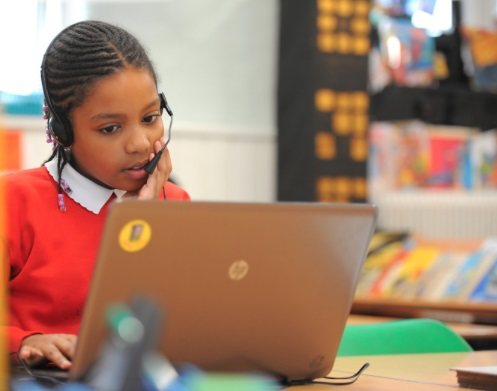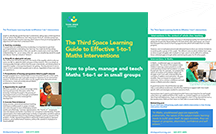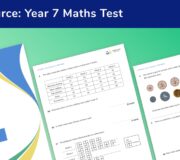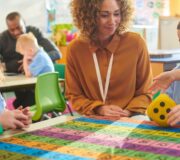20 Primary Maths Strategies Proven To Improve Progress And Understanding At KS2
Working with thousands of pupils every week we’ve developed a clear schema of the primary maths strategies that really make an impact on pupil attainment and progress in maths at KS2.
These primary maths strategies are drawn from the most effective teaching strategies we believe you need when teaching the primary maths curriculum.
Since the arrival of the new curriculum and primary maths framework here at Third Space Learning we have delivered online maths intervention programmes to over 60,000 primary school pupils. Every lesson is taught by professionally trained maths tutors working one to one with the child.
Origins of our primary maths approach
As part of our quality control and to ensure the best outcomes for every child we realised early on that we needed a clear framework for our tutors to follow – a rubric that identifies the ‘Third Space Learning’ approach.
So, drawing on what we know about quality first teaching and a maths mastery approach, as well as the specific requirements of online tutoring and tutoring in a one to one environment, this is the list of what we believe to be crucial in primary maths, and indeed, what every subject leader or teacher involved in primary maths teaching should be aware of.
We hope that it proves to be valuable in helping you to reflect on your own primary maths practice and that there will be an idea here that you can take to further support your own pupils with primary maths.
- 1: Build interest and rapport
- 2. Know your pupils and your resources
- 3. Recap prior learning
- 4. Share lesson objectives to improve maths progress
- 5. Teach key maths vocabulary
- 6. Use AfL to adjust pitch and pace
- 7. Personalise learning and link questions to pupils’ interests
- 8. Create more opportunities for pupil talk
- 9. Use ‘Concrete Pictorial Abstract’ method
- 10. Use variation to improve maths progress
- 11. Frame questions in a real world context
- 12. Vary approaches to questions
- 13. Move from scaffolding to independent practice
- 14. Use deeper questioning strategies to help pupils progress in Maths
- 15. Use bar-modelling techniques
- 16. Nurture a growth mindset to nurture maths progress
- 17. Provide a range of strategies and next steps
- 18. Encourage metacognition to encourage Maths progress
- 19. Reward, praise and encourage the pupil
- 20. Teach the teacher
- A note on resources
Why are these strategies important in primary maths?
Excellence in primary maths depends on a combination of factors – the right primary maths resources, good quality teaching backed up by regular CPD, strong subject leadership in the school from the maths coordinator, and a whole school maths curriculum and progression from EYFS Early Years, through to Key Stage 1 and Key Stage 2 that teachers understand and feel ownership of.
One of the joys of primary maths (unlike other subjects like History or Geography) is that each piece of new knowledge builds on prior knowledge.
Provide children with the building blocks of place value, and explain to them the value of learning their number bonds, and by the time you get to addition and subtraction in KS2, much of the cognitive load of learning a new technique like column subtraction with exchanging will be lifted.
Similarly without a good grasp of times tables, not only will your pupils struggle on their multiplication tables check, but, arguably more importantly, they will find long division, fractions and even pie charts, significantly harder.
With a whole school approach the child’s learning journey in primary maths can progress logically from early numeracy through to the more sophisticated calculations and reasoning they make as they are ready to transition from Year 6 to Year 7.
Read more: Ready To Progress?
The list of primary maths strategies
These are the primary maths strategies we use to ensure progression through every tuition lesson we deliver.
1: Build interest and rapport
Nothing captures a pupil’s imagination more than their own interests! While learning your pupils’ hobbies and favourite pastimes can be time-consuming, it should happen naturally over the course of the year. You can then use this knowledge to personalise classroom explanations.
Our 1-to-1 Maths specialist tutors prepare for each lesson by thinking about how they can effectively engage pupils and relate content to their interests and use images related to these to personalise the session. It’s simple, but it’s also a great way to turn a new concept from ‘mundane’ to ‘memorable.’
With your own KS2 maths class while you cannot personalise for every child, engaging children with fun real life maths activities and is a great start.
2. Know your pupils and your resources
This should be the bread and butter of teaching for interventions (and in general). If you’re not sure if a maths resource is pitched at the right level for your pupil(s), then you need to find out. Without appropriate differentiation in the classroom, time spent on a resource could well be time wasted.
Before your intervention, look at previous session data or pupil profiles. Are there any areas you should be aware of, such as EAL, dyscalculia, etc?
Like our tutors, we advise you tally this against the intervention resources and make notes against any potential areas of difficulty, or likely misconceptions. Remember, forewarned is forearmed and avoiding speed bumps when time is limited is crucial to maximising learning.
With a class of 30 it can be more tricky to ensure you’re aware of every misconception. We recommend using diagnostic assessments wherever possible at the start and end of every topic. See also this blog post on effective mixed ability grouping in Maths.
3. Recap prior learning
Particularly in Maths, where learning needs to build upon previous learning and foundation concepts, recapping prior knowledge through retrieval practice or other methods is essential.
When teaching pupils through our specialist Maths intervention, our tutors always create a linking question from past lessons to kick-start learning in a new one.
This can save precious time and ensure you never try to teach a new concept to a class that they’re simply not ready for.
4. Share lesson objectives to improve maths progress
Don’t assume that just showing your class the learning objectives will make them understand them. Our tutors do this by; asking pupils to identify keywords they don’t understand, and asking open ended questions such as ‘what is the difference’ and ‘what do you think of’, and discussing how the lesson objectives link to prior learning.
Discussing lesson objectives is much better for long term memory retention than just stating them.
Third Space Learning Guide to Effective 1-to-1 Interventions
How to plan, manage and teach 1-to-1 and small group KS2 Maths interventions to make best use of the resources you have
Download Free Now!5. Teach key maths vocabulary
If a pupil does not understand key maths vocabulary, it is important to get them up to speed before undertaking new learning. To address any misunderstanding, our tutors will often get pupils to describe mathematical terms in their own words before they start a topic.
Plus if pupils are struggling they will simplify keywords and, for example, discuss ‘sharing’ instead of ‘division’.
6. Use AfL to adjust pitch and pace
Where possible, learning should be paced to the needs of the pupil(s). The last thing any teacher wants is to find that they have moved too quickly through a topic and caused cognitive overload in their pupil(s).
New to cognitive load theory in the classroom? Read Clare Sealy’s post on the topic to find out more about this valuable educational psychology tool, with a focus on how it impacts primary school pupils.
This is is why our tutors use assessment for learning and formative assessment strategies to adjust the pitch and pace of their lessons.
This is as simple as moving quickly through content that the pupil understands, and slowing down to expand or explain a concept that they’re not getting.
The key element is not to move on from content that a pupil is yet to secure, regardless of how much time you spend on it.
7. Personalise learning and link questions to pupils’ interests
Personally relevant problems are way more fun to solve. Posing a question in the context of the pupil’s name, or their favourite animal, is likely to increase their engagement.
To this end, our tutors often use the pupil’s name, favourite animal, or interests to create personally relevant Maths problems for them to solve. As familiarity and rapport with your class builds throughout the year, this should become easier and easier to do.
We’ve got plenty of maths activities you can use to personalise learning to pupils’ interest such as this football maths lesson, this Science in Maths activity or a KS2 maths investigation into famous female mathematicians for International Women’s Day.
8. Create more opportunities for pupil talk
Finding time for high quality maths talk in a KS2 class is hard. But, wherever possible, you should encourage active learning and promote discussion rather than lecturing.
Short attention spans are an ever-present hurdle and classroom discussion keeps students from zoning out. Plus it enhances metacognitive development.

Remember, however, that direct instruction is still often your most valuable teaching method. Pupil talk should come after you’ve covered the fundamentals of a topic, not before.
9. Use ‘Concrete Pictorial Abstract’ method
The CPA Concrete Pictorial Abstract method is a staple of many Maths teachers’ toolkit. Use real objects to build the pupils’ foundations for conceptual understanding, and follow up with pictorial representations that help them freely conceptualise a problem.
This technique is tried and tested and not just for low ability students; using it enables all pupils to grasp more challenging content quickly and effectively.
10. Use variation to improve maths progress
There are two stages of this. Conceptual variation, which shows pupils different ideas that underpin a mathematical concept, can be framed using questions such as ‘what’s the same?’ and ‘what’s different?’ between different representations. It helps pupils distinguish the essential and obscure characteristics of a maths concept.
Procedural variation, which is more useful for multi-step operations and comparing successive procedures (e.g. calculating two different sets of numbers), can be framed as questions such as ‘what do you notice?’ and ‘is there a relationship between?’
11. Frame questions in a real world context
Connecting topics to maths in the real world makes them more memorable and engaging. This should be done as often as possible and our tutors are expected to connect all Maths learning to real life, even in more abstract topics!
For example, if a tutor is teaching rounding up to 1 million, they make look at different populations in towns or cities or ask pupils to round up the total of people in their hometown.
If you’re looking for quick and easy topical maths investigations to use in the classroom, take a look at these resources for Year 5 and Year 6:
12. Vary approaches to questions
There’s a big difference between learning a method and gaining real understanding.
Our tutors always teach multiple ways to approach the same problem. For example when teaching rounding tutors can use a number line, or ask pupils to simply use the relevant columns to inform their rounding.
They also make frequent use of goal-free problems and open-ended questions to ensure pupils learn the underlying concept, rather than simply performing back what they have seen.
This is especially crucial for Year 6 pupils who need the tools to answer SATs questions independently.
13. Move from scaffolding to independent practice
Learning should be structured with gradually decreasing support: from scaffolding to independent learning and finally to stretching. In our intervention, tutors always model answers and show pupils the steps to success before asking them to answer a question.
Moreover, when moving towards the plenary of a lesson, our tutors provide multiple opportunities for pupils to work independently and extend their own learning.
Find out more about the 5 stages of deliberate practice here.
Read more
- How to Stretch and Challenge More Able Pupils in KS2 Maths
- The 21 Best Maths Challenges At KS2 To Really Stretch Your More Able Primary School Pupils
14. Use deeper questioning strategies to help pupils progress in Maths
We all know verbal reasoning plays a large part in improving metacognition, but it is the quality of a discussion is what counts, not the quantity!
Like our tutors, you can encourage quality pupil talk by questioning in the classroom in Maths like ‘how did you get to this answer?’ and ‘how would I extend this question?’ This also addresses the three main aims of the national curriculum: fluency, reasoning and problem-solving.
15. Use bar-modelling techniques
Bar-modelling is taking the primary Maths world by storm for a reason. From routine calculations such as 4 + 3, to more complex multi-step SATs problems, bar models are a fantastic learning aid as they show the inner workings of Maths problems. Here are 25 word based problem solving questions with bar models to get you started.

16. Nurture a growth mindset to nurture maths progress
Research clearly demonstrates that, compared to other subjects, pupils are most likely to believe they won’t succeed at Maths. To build that crucial confidence our tutors always praise the effort a pupil puts in, rather than the pupil.
We find phrases like ‘you found a really good way to do that!’, or ‘I can tell you’ve been practising’, really improve motivation and attitude towards Maths.
Read more on how to get growth mindset right in primary schools.
17. Provide a range of strategies and next steps
Just as linking from previous concepts gives pupils a sense of familiarity, linking to future concepts ensures that pupils don’t get “lost” in learning. This is why our tutors always signpost the learning in any given lesson.
Signposting can be as simple as telling pupils that ‘we’re going to move on to a rounding numbers to a million, it’ll use the same strategies as rounding to ten thousand, but it’s more of a challenge’. This keeps pupils engaged and on track.
It’s particularly important when developing reasoning skills at KS2.
18. Encourage metacognition to encourage Maths progress
Metacognition should be an integral part of lessons and pupils should frequently be assessing their own learning using metacognitive strategies and other thinking skills.
One way to do this is to focus the plenary on what was learnt that day and, more importantly, how it was learnt. When a child can reflect on their own understanding, what they found more challenging or easier, then you will be starting to achieve metacognition in the classroom.
19. Reward, praise and encourage the pupil
Praise is a great confidence-builder, and corrections can be incorporated constructively within praise. For example, ‘it’s okay that you’ve made a mistake but it’s important that you learn from it. This is especially crucial with pupils who may have less maths confidence than their peers and those struggling with maths anxiety.
20. Teach the teacher
To be effective, pupil talk requires proper structure and expectations. One technique we use is to ask a pupil to teach back to the tutor (towards the end of the lesson). It is the ultimate test of understanding.
It’s particularly effective in 1-to-1 settings, where the pupil is under less pressure than in a group. However, when used as a group activity (with more confident pupils doing the teaching) it can be effective in a classroom setting.
If you’re new to this one, why not start by trying it as a primary maths strategy to help your pupils memorise their number facts.
Those are the 20 primary maths strategies that underpin our interventions.
A note on resources
The only other thing to mention is that in our online maths lessons, tutors are provided with a full range of online lesson slides to follow.
For primary teachers with their own classroom activities to prepare, we’ve provided a number of free maths resources and premium teaching resources (including many designed for those following White Rose Maths and other primary maths schemes of work) as part of our online maths hub.
And don’t forget to download our full, FREE guide to effective 1-to-1 Maths interventions here.
DO YOU HAVE STUDENTS WHO NEED MORE SUPPORT IN MATHS?
Every week Third Space Learning’s specialist online maths tutors support thousands of students across hundreds of schools with weekly online 1 to 1 maths lessons designed to plug gaps and boost progress.
Since 2013 these personalised one to one lessons have helped over 150,000 primary and secondary students become more confident, able mathematicians.
Learn how the programmes are aligned to maths mastery teaching or request a personalised quote for your school to speak to us about your school’s needs and how we can help.




